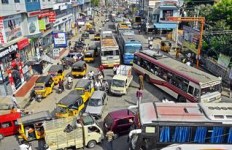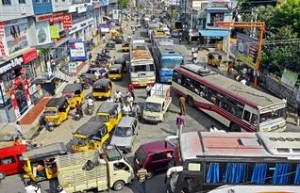
Road safety – Heard of that?
Road safety – have we heard of this term in India? I certainly haven’t but politicians have started talking about it now because 1 of them (a senior minister) died in a Road Traffic Accident (RTA). This is definitely a good sign as political will has a great impact in India.
WHO has estimated that more than 231027 people in India die of RTA’s every year. The stats are alarming
1. India accounts for 12% of the world’s total accident fatalities
2. A third of the people who are killed in RTA’s are under the age of 25
3. A third of the people who are killed are either 2 wheeler or 3 wheeler drivers or passengers.
The most interesting point to note here is that there is no actual recorded data for the number of accidents that happen on India’s roads. I think it’s no point talking about how unsafe are our roads and instead I want to focus on how to make our roads safer. I am writing this blog to highlight some of the road safety measures followed in different countries which can be used to formulate road safety rules in India.
Basic safety rules
Everybody should wear a seat belt – In the UK law if a passenger is found not wearing seat belt the driver is actually fined 50£, obviously this would mean the driver ensures that all the passengers are wearing seat belts.
Anybody driving or riding a 2 wheeler should wear helmets.
Children under a certain age and under a certain height should be seated in a child seat.
If it’s a 2 seater vehicle only 2 people are allowed and if it’s a 5 seater car only 5 people are allowed to ride in the vehicle.
Vehicle safety requirements
All vehicles should have insurance, tax paid.
All vehicles should undergo a very basic fitness test called MOT (Ministry of transport) test which will ascertain if the car is road safe. If the car fails the MOT then the required changes have to be made and presented again to pass the test. If you drive a car without a valid MOT you get a hefty fine.
All cars should have air bags fitted for the driver and passenger.
No honking ever. Think about the amount of noise pollution and the diseases it causes and what have we achieved by honking.
Make sure all your lights, indicators are working, if they are not and the police spots you, you have to pay a fine.
You are not allowed to drive with a high beam as this can be a major distraction to the driver in front of you and opposite to you. Always use low beam.
Driving license
The theory test which I took in India was a joke as the agent filled in all my answers and the practical test was driving for less than 50 m with 4 people sitting in the same car. As we all know most of them don’t even take the practical test but are able to get (buy) a driving license. This should change and should be the first point of addressing road safety.
In most of the countries it involves a 2 stage process of passing a theory test and a practical test.
The theory test is an online test which happens in a test centre.
The Practical test involves the candidate driving with the examiner on normal roads during normal hours for about 1 hour, you are also tested for your parking skills and manoeuvres. You are basically tested in real driving situations. The examiner marks the candidate based on the number of minor mistakes and major mistakes. If you have 1 major mistake you are failed and have to retake the test.
If you are a learned driver you should have an L plate displayed and should be driving accompanied by somebody who has held a license for atleast 3 years. People who have recently passed their test can display a P plate for a few months until they become more confident to drive.
Road signs
UK has 1 of the most effective and reliable system of road signs when compared to the rest of the countries. Clear road signs means more focus on driving and less chance of mistakes and accidents. So what are the basics which would ensure that we are safe on our roads? I am highlighting some of the most important ones which we need to have.
1. Speed limit – There is no guidelines about speed limits in India and there are no sign boards telling the speed limit. In the UK Speed limit is simplified depending upon the roads you are driving. For example if you are driving in a residential area with street lights it is automatically 30 mph unless otherwise displayed. The national speed limit is 70 mph for motorways (3 lanes) and dual carriage way (2 lanes). There are single carriage ways which have a speed limit of 60mph. These are standard speed limits for approx. 80% of the roads in UK.
2. There are different types of pedestrian crossings, display clearly which type of crossing it is.
3. If there is going to be work undertaken on any of the roads they are clearly displayed well in advance and the times the road will be closed etc. Most of the time work is done during the weekends or after office hours to make it convenient for the public.
4. Services and petrol stations are all situated in designated places and they are marked clearly with signs for exit etc.
5. Electronic sign board are present throughout the motorways and dual carriage ways which are used to notify congestion, accidents, change in speed limit, parking availability etc.
6. Roundabouts are 1 of the best creations and they work brilliantly. Signs are displayed when you are going to be approaching a roundabout and the exit destinations for that roundabout.
7. The obvious things on the display boards are places, attractions in that place and the distance to get there.
Infrastructure
This is 1 of the most important things which India needs for our ever growing population.
I want to mention about something called “Hard shoulder”. Hard shoulder is an extra lane in most of the motorways for access to emergency service vehicles and police. In the event of an accident the police or the ambulance can get to the accident spot without going through miles of traffic by using this lane and can get to the spot quickly. This is also a lane for people who have breakdown problems or any other emergency. It’s a serious offence for moving traffic to use this lane unless instructed by authorities. This basically ensures that lives are saved and traffic congestion is reduced.
Signals work 24/7 unlike in India which stops at some point during the night.
Cameras- Cameras are everywhere to monitor traffic movement but also to spot people breaking laws.
The big question I get asked is do we have pot holes in other countries, of course they do but they are very minimal and nothing compared to the pot holes sizes on Indian roads. Pot holes are reported and are immediately fixed, if you suffer damage due to pot holes the local council are accountable for it and you may be entitled for a compensation.
Computerise the whole process of getting a license, insurance, MOT, Tax and everything related to road safety, it will save a lot of money and time. It will also ensure that 1 breaking the law can be identified and punished rapidly.
Offences and penalties
Cameras are the eyes of the law. There are speed cameras which captures the registration plate if you break the speed limit and you get a speeding ticket for that. You also get three points on your license for every single offence. In the 1st 2 years if you get 6 points your license is revoked and you have to go through a new application process. After 2 years you are allowed up to 12 points before your license is revoked.
Anytime you break the law like not paying your tax, insurance or drive a car without MOT you have to pay fine. There are cameras everywhere which capture number plates and analyse this information, so human presence is not required and offenders will still be caught.
Audit
The government collects data about everything related road safety like accidents, death related to accidents, fines, penalties etc. This is a very useful tool when planning for road safety. For example if on a particular road there have been more accidents they analyse the reason for it and make changes like reducing the speed limit on that road or installing a speed camera.
Indian government and the state governments in India should start collecting data and use that to improve road safety.
Education
Education is the key to road safety. Road safety awareness should be promoted at home, schools, public places through media and various government programs and initiatives. This will definitely have a long term positive impact on road safety.
We really have a long way to go in terms of making our roads safer but it’s not too late to start. I want to finish by saying how a friend of mine compared driving in India to UK. In India people drive thinking that nobody follows the law as opposed to UK where people drive thinking that everybody will follow the law. I guess that’s something to think about!!





